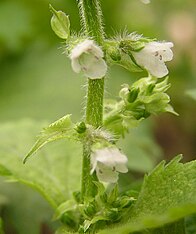Perilla oil
| Perilla oil | |
|---|---|
| Raw material plant (noun) |
Perilla plant ( Perilla frutescens ) |
| origin |
Seeds |
| colour |
light yellow |
| ingredients | |
| Oleic acid | 13-20.5% |
| Linoleic acid | 10.5-20% |
| Linolenic acid | 52.5-64% |
| Palmitic acid | 4-9% |
| Myristic acid | <0.4% |
| More fatty acids | Stearic acid 1–3.8%, arachidic acid <0.4% |
| Other ingredients | Tocopherol up to 680 mg / kg, phytosterols 3.5 g / kg |
| properties | |
| density | 0.927-0.933 kg / l at 15 ° C |
| viscosity | = 25 mPas at 38 ° C |
| Oxidation stability | <2 h |
| Melting point | −12 to −17 ° C |
| Smoke point | 160 ° C |
| Flash point | 300 ° C |
| Iodine number | 170-206 |
| Saponification number | 187-197 |
| Calorific value | 39 MJ / kg |
| Manufacturing and Consumption | |
| Most important production countries | Korea , China, Japan , India , Myanmar |
| use | Edible oil , technology, industry |
Perilla oil , also egoma oil , is a vegetable oil obtained from the roasted seeds of the green-leaved variety of the perilla plant ( Perilla frutescens ). Native to East and Southeast Asia, the plant originally comes from the mountainous areas of India and China . Today it is also used in Austria, USA etc. a. Countries cultivated. The light yellow oil is reminiscent of linseed oil in taste and smell .

The triglycerides in perilla oil have a particularly high proportion of the omega-3 fatty acid residue , which is derived from alpha-linolenic acid. The human body cannot produce omega-3 fatty acids itself and must therefore take them in with food. Perilla oil also contains the terpenes perilla alcohol , perilla aldehyde and perilla acid .
In the past it was also used as lamp oil, heating oil and impregnation oil. In addition, the oil is used as paint, ink and preservative in soy sauce , as well as used to make linoleum .
Web links
- Cheating aging - herbal ingredients from Asia on healthindex.de.
- Perilla oil at Zeno.org .
- Perilla oil - a newcomer among the vegetable oils on openpr.de.
literature
- S. Krist, G. Buchbauer, J. König, C. Klausberger: Lexicon of vegetable fats and oils. Springer, Vienna New York 2008, ISBN 978-3-211-75606-5 , pp. 353 f, ( limited preview in the Google book search).
Individual evidence
- ↑ a b c d e f He-Ci Yu, Kenichi Kosuna, Megumi Haga: Perilla: The Genus Perilla. Harwood Academic Publishers, 1997, ISBN 978-90-5702-171-8 , Taylor & Francis, 2004 (Reprint), pp. 93-98.
- ↑ a b c d e f Youfang Ding et al: Characterization of fatty acid composition from five perilla seed oils in China and its relationship to annual growth temperature. In: Journal of Medicinal Plants Research. Vol. 6 (9), 2012, pp. 1645-1651, doi : 10.5897 / JMPR11.1436 .
- ^ A b Giovanni M. Turchini, Wing-Keong Ng, Douglas Redford Tocher: Fish Oil Replacement and Alternative Lipid Sources in Aquaculture Feeds. CRC Press, 2010, ISBN 978-1-4398-0863-4 , p. 217.
- ↑ a b c d e Ullmann's Food and Feed. Vol. 2, Wiley, 2017, ISBN 978-3-527-33990-7 , pp. 665, 711, 720.
- ↑ DR Erickson: Practical Handbook of Soybean Processing and Utilization. AOCS Press, 1995, ISBN 978-0-935315-63-9 , p. 33.
- ^ A b Betty M. Watts, Lillian Hoagland Meyer: Food Chemistry. Reinhold, 1961, p. 27, OCLC 395146655 .
- ↑ E. Bames, A. Bömer et al.: Handbuch der Lebensmittelchemie. 4th volume: Fette and Oele , Springer, 1939, ISBN 978-3-642-88819-9 , p. 482.
- ↑ Entry on perilla oil. In: Römpp Online . Georg Thieme Verlag, accessed on May 23, 2011.
- ^ Adrian Gerber: Community and State. The Central Japanese Village Ōyamazaki in the Late Middle Ages. Lucius & Lucius, 2005, ISBN 3-8282-0260-8 , p. 411.


